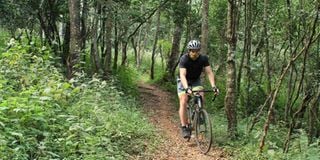Thrill in the forest

Cycling in Ngong Forest.
What you need to know:
- I did a bit of research and found the Ngong Road Forest Association website.
- I was curious to visit the forest and so last Saturday afternoon, I cycled to the main gate of Section 4 adjacent to the Nairobi War Cemetery.
A few years ago, a good friend of mine told me a story that has stuck with me. He was driving around town with his buddies one evening; with a chocolate cake from Java on the backseat.
They hit traffic on Ngong Road, and decided to take the loop behind Jamhuri Park. It was getting dark, and the road skirting the forest was rough, so they were driving really slowly.
Some armed thugs suddenly jumped out in front of them, robbed them of their valuables and disappeared into the forest. My friend was shaken, but mainly sad because he’d lost his cake.
I now frequently think of chocolate cake when I drive past that section of Ngong Road. And, for a long time after he told me that story, I had a very negative perception of Ngong Road Forest Sanctuary.
It was a view compounded by tales of golfers being mugged on the 8th hole of the adjacent Golf Park.
It was only until a few weeks ago when I received photos of sunny glades and riverside trails on a WhatsApp group for runners that my view of the forest softened. I had started to hear glowing reviews from runners, cyclists and dog-walkers of safer, better maintained tracks, and of marked out 5, 10, 15 and 21 km routes.
I did a bit of research and found the Ngong Road Forest Association website. It doesn’t seem to have been updated for a while, but it includes a link to a comprehensive plan to conserve the forest.
Creating five partitions
The document describes the forest as divided into two main sections by the Ngong Road — the Miotoni section to the north west, and the Racecourse and Kibera sections to the south east. Both of these main sections are split by the Southern Bypass, creating five partitions. ‘Section 4’, bordering the Racecourse, is by far the largest.
It goes on to detail the history of the forest – a story of land grabbing and intense lobbying for its protection led by Dr Imre Loefler. Encroachment and illegal land acquisition are still very public, ongoing challenges facing the Ngong Road Forest Association. Its main strategy to solve these and other problems is to first secure funding for a perimeter fence, and then to improve community and visitor activities.
I was curious to visit the forest and so last Saturday afternoon, I cycled to the main gate of Section 4 adjacent to the Nairobi War Cemetery. Here, I met two Rangers, or ‘Scouts’, who offered to show me around the Imre Loefler Education Centre, where they teach groups about the importance of the forest.
One of the scouts suggested that he cycles with me along the 10km route. So together we headed into the forest, eyes fixed firmly on the winding dirt track ahead of us.
Aardvark holes
We weaved in between aardvark holes and over thick lines of safari ants. Every now and again I had to duck to my handlebar like Chris Froome on a steep descent to avoid low branches across the trail. My guide said they had been constructed to discourage horses from churning up the main paths.
We followed clumsily painted rocks and tree trunks marking the 10km route. Apart from a strolling couple, and a pack of dogs and their walker, we were mostly alone. With the distant drone of bees in the canopies, the flutter of birds as we cycled past, and the odd darting duiker and tree hyrax, it was very peaceful.
It’s difficult to know for sure how safe the forest is, especially towards the fringes of Kibera. But there are signs of improvement, and with a bit of investment and support from the government, there is no reason why the forest can’t be as successful as Karura.
For more information, head to the Ngong Road Forest Association Facebook page. Email: [email protected]





